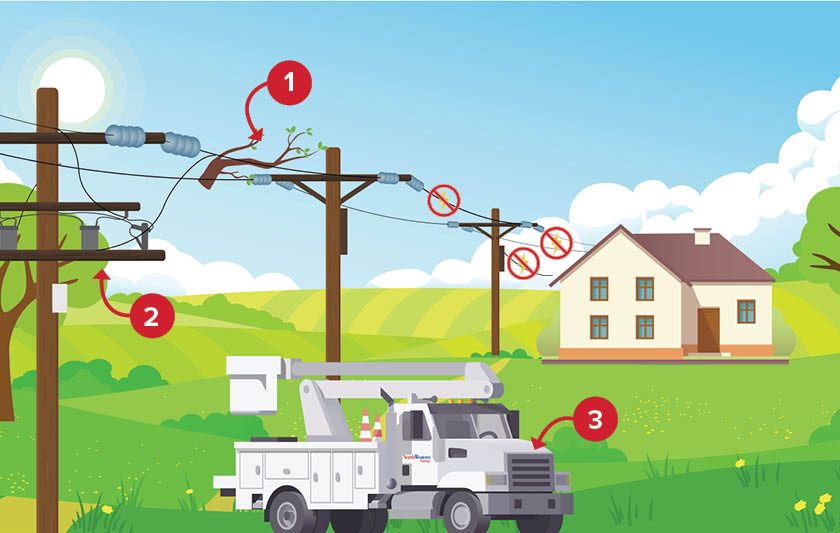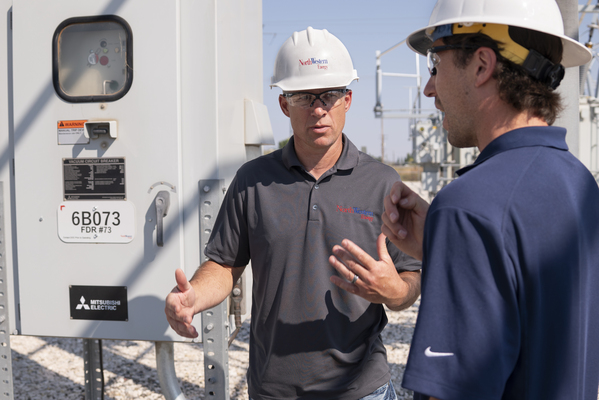Enhanced Powerline Safety Settings
We use Enhanced Powerline Safety Settings (EPSS) to make the electrical system more sensitive to potential hazards. If a fault occurs, such as a tree branch contacting a powerline, power is shut off automatically to reduce the chances of starting a wildfire.
When fire risk is low, if a tree branch contacts a powerline or another fault occurs, our system is designed to quickly clear that fault. You might notice this as a brief light flicker — that’s the system working to keep your power on safely and reliably.
However, when fire risk is elevated, those same faults could potentially spark a wildfire. That’s why we adjust how we operate the grid: to continue providing safe and reliable power while reducing the risk of igniting a fire.
A line that has been automatically de-energized will remain off until our crews can patrol the area to check for damage before safely restoring power. This can result in more frequent, unplanned outages that can last several hours, depending on repairs and patrols.
Wildfire-safe operations

Wildfire-safe operations
- Fault condition, such as a tree branch on a power line, occurs.
- Equipment settings shutoff power within 1/10 of a second.
- Lines are assessed for faults and repairs are performed prior to re-energization.
What are Enhanced Powerline Safety Settings?
During high-risk conditions, NorthWestern Energy enables Enhanced Powerline Safety Settings (EPSS) on targeted lines to turn power off faster when there is a potential hazard, such as a tree branch touching a line. This helps prevent sparks, and it also make it more likely that you may experience power outages when these settings are in place. This is an unplanned outage and is not a Public Safety Power Shutoff.
If you're experiencing an outage, check our Outage Map for more information or to report your outage.
What should I expect when EPSS are enabled?
NorthWestern Energy will consider enabling Enhanced Powerline Safety Settings (EPSS) on targeted power lines during high-risk wildfire conditions, including strong winds, very dry vegetation, and low humidity. These conditions tend to be more prevalent in the summer and early fall in areas of high wildfire risk.
Enabling EPSS helps keep you safe, but this also means customers may experience more frequent unplanned power outages while EPSS are in effect. We know that power outages can be inconvenient, and we want you to be prepared.
NorthWestern will work to safely restore power as quickly as possible, but there can be challenges if there is limited access or visibility, extensive damage to the system, or active fires nearby. Patrolling and repairing damage could take several hours or longer depending on the damage.
Customers will be notified of outages via text or email if they are enrolled in alerts.
How will I receive outage updates?
Like any unplanned outage, NorthWestern Energy will communicate with customers impacted by EPSS outages.
- Be sure you are signed up for email and/or text outage alerts.
- Be sure your contact information is up to date by logging into My Energy Account or contacting us.
- You can visit our outage map for estimated restoration times and other updates.
How should I prepare for outages?
Learn what steps to take before, during, and after an outage by visiting our outage safety page. Make a family emergency plan and prepare an emergency kit.
- Be sure you are signed up for email and/or text outage alerts.
- Be sure your contact information is up to date by logging into My Energy Account or contacting us.
- Remember, if you see a downed power line, always assume it’s energized and stay as far away as you can. Call 911 and NorthWestern Energy to report the downed line.
Frequently asked questions
Where are EPSS being used?
How are EPSS different from a PSPS?
During wildfire season, NorthWestern Energy takes proactive steps to ensure safety while balancing reliability. These prevention measures and response activities can result in power outages. NorthWestern makes the electric system more sensitive to potential hazards, such as a tree touching a line, and then automatically turns off power to prevent fires. The resulting outage is unplanned.
A Public Safety Power Shutoff (PSPS) is a measure of last resort to protect our communities from potential wildfires. Public Safety Power Shutoffs are used only extreme situations during severe fire weather. PSPS are planned outages with advance communications to the area that will be impacted. Our Wildfire Mitigation Plan includes numerous strategies to prevent our power lines from sparking a wildfire. Public Safety Power Shutoffs are used only in extreme situations during severe fire weather.
What are the thresholds for EPSS to be enabled?
How do EPSS help with wildfire risk management?
Enhanced Powerline Safety Settings make the electric system more sensitive to potential hazards and automatically turn off power to reduce the risk of sparking a fire.
In normal conditions, NorthWestern Energy uses devices called “automatic reclosers”. These devices will attempt to reconnect the power when confronted with a hazard, such as a tree branch brushing against a line, in case the hazard is no longer an issue. When EPSS are enabled, the reclosers’ settings are changed to no longer attempt to reconnect power to protect against potential sparks. Enabling EPSS helps keep you safe, but this also means that customers in these areas may experience more frequent unplanned power outages.



